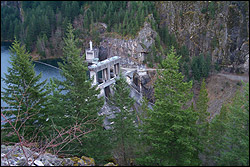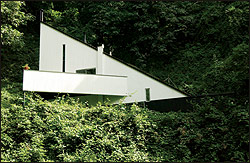Despite careful management of water supplies by government officials and utilities, Washington is still facing a shortage in this drought year, though the effects are not immediately apparent. “Droughts unfold slowly, affecting different things at different times—it’s almost a slow-moving natural disaster,” says Curt Hart, a spokesperson for the state Department of Ecology’s water- resource program. “Right now, drought conditions are most severe in the Yakima Valley and all over Eastern Washington.” Meanwhile, in the Puget Sound area, the Department of Ecology is seeing some rivers dropping to record low levels.
This state of drought, a month before summer even begins, is due to last winter’s unusually warm temperatures and less-than-normal precipitation, which resulted in greatly reduced snowpack in the mountains. Mountain runoff is Seattle’s primary source for water and electricity. Normally, melting snow slowly feeds streams and rivers when water is most needed, during the dry seasons of summer and early fall. Because snow levels were at 35 percent of normal, many rivers this year will be largely dependent on rainfall.
Experts are hesitant to tie last winter’s weather to climate change, but Cliff Mass of the University of Washington atmospheric sciences department says a long-term warming trend is under way in the region, measurable over decades. That doesn’t necessarily mean a significant change in precipitation amounts, he says, but warmer weather does have implications for precipitation storage. If it’s too warm for snow to accumulate, all the water runs off the mountains and cannot be used later in the year for people, crops, and fish.
The last time there was a statewide drought was 2001, when snowpack was greater than this year’s. But the water situation this time, in metropolitan Seattle, at least, is better for two reasons. First, the two Seattle utilities that rely on mountain water—Seattle Public Utilities and Seattle City Light—have paid closer attention to climate data and managed the levels at their reservoirs accordingly. Second, human water consumption now is less, thanks to conservation measures.
Seattle has two kinds of reservoirs in the Cascade Mountains and foothills. For water supply, Seattle Public Utilities, which supplies 1.3 million people in Seattle and its suburbs, manages two watersheds, those of the Cedar and Tolt rivers, with dams and reservoirs to store, supply, and release water as needed. Snowpack in those watersheds is completely gone. Seattle City Light has dams on several rivers, most notably the Skagit in the North Cascades, to generate most of its electricity. Both utilities use weather data from the University of Washington and the National Weather Service. Predictions are made for precipitation, temperature, wind, and dew point for next week and beyond—even to next year. The utilities also track snowpack and water content to determine what’s going to happen in the watersheds that feed the reservoirs. Management of reservoir water levels is very important and can be tricky. How much water should be released ahead of a storm? You want to hang on to as much as possible, but if reservoirs are too full, there’s a danger of uncontrolled spill, which causes downstream flooding and has a scouring effect on fish spawning beds. This year’s dry winter and premature loss of snowpack prompted the utilities to retain a great deal of water that would normally have been released.
Another big difference from 2001 is that water consumption is much lower. Seattle residents have embraced conservation techniques. According to Seattle Public Utilities, 400,000 more people are living in the metropolitan area, but water usage is back to what it was in the early 1970s. That conservation can be traced to public awareness campaigns and rebates to consumers for purchasing appliances and fixtures that use low amounts of energy and water. The utilities have also decreased consumption within their own organizations during this drought—for example, reducing the amount of water used for reservoir cleaning and limiting the number of spills done to maintain water quality.
It’s difficult to predict how the drought will play out in terms of water availability. Guillemette Regan, strategic adviser for Seattle Public Utilities, says voluntary conservation by customers in 2001 was sufficient to deal with the shortage then, and that cooperation could head off any mandatory rationing this time, too. “We don’t ask our customers to take on more than is absolutely necessary.”
With electricity, it’s a little different. Seattle City Light is cautious. A shortage isn’t likely, but the cost of acquiring energy can increase if the utility’s own dams can’t generate the usual amount of electricity. Says power supply officer John Prescott: “We’re going to be able to cover electric power, protect the fish, and sell less on the open market than planned, which means it could potentially impact rates, which are determined by the City Council. Also, the less hydroelectricity we produce, that means other sources are increased,” and those other sources could be greenhouse-gas-emitting plants burning coal or natural gas.
Water flows through our lives in an endless cycle affected by climate change and other things, but it’s a finite resource. Says Hart, the state Department of Ecology spokesperson: “One thing we can’t do, we can’t make water, can’t make up for what Mother Nature didn’t give us.”
For suggestions on how to use water wisely and for information about water-saving rebates, go to www.savingwater.org. For more on the statewide drought, visit www.washingtondrought.org.







